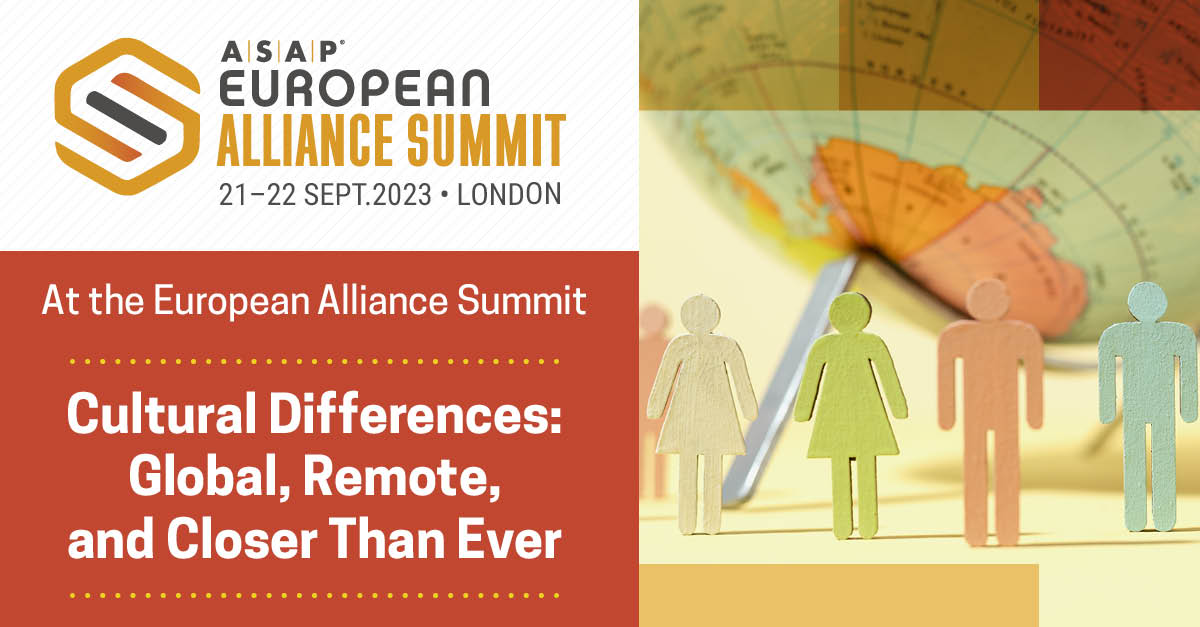Cultural Differences: Global, Remote, and Closer Than Ever
For good or ill, the pandemic changed so much about the way we do our jobs and live our lives—managing alliances included. Nor is it yet in the rearview mirror, and we’re still going about our business as best we can under its spell.
The spread of remote work is one of the obvious aftereffects, and like others it’s a mixed blessing. It’s great that some of us are able to do it, and in some respects it’s made us more global, made the faraway more immediately present. But there can be disconnects, misunderstandings, language barriers, and other aspects of communication that get in our way.
Cultural differences have long been a part of alliances, especially when they are global in scope. But in an increasingly globalized, interconnected world, with far-flung teams working remotely or in hybrid situations, these differences can loom ever larger.
What Time Is It? Time for a Biscuit
Using a bit of psychology to understand our differences—along with a healthy dose of good common sense and basic human respect—was the subject of a presentation at last week’s ASAP European Alliance Summit held in London, “Cultural Differences for Alliances in a Global Environment.” The presenter was Elena Cavalli, CSAP, head of commercial alliances at Astellas, who spoke with me—remotely, of course—beforehand.
Cavalli joked that for her, presenting on the last day of the conference, “It’s not an easy slot, let’s put it that way! I’ll try to keep it quite light, and talk about the joyful side of our job; there’ll be quite a few photos.”
One image Cavalli planned to present was a composite of photos of biscuits. Depending on the part of the world you’re in, a biscuit could be sweet or savory, baked hard or soft, an accompaniment to dinner or a nice dessert after a meal. But in any form, the act of having a biscuit brings “joy and connection,” according to Cavalli—similar to the spirit of a collaborative alliance, regardless of where you are located on the planet.
“Whether we’re in an alliance or in an internal team, we’re all human beings,” she said. “Broadly speaking, as human beings we generally all have the quirks, the differences—we all have values, not saying they’re the same, but people have aspects that characterize them as human beings.”
Zooming with the Big Dogs
Awareness of and sensitivity to the nuances of cultural differences, Cavalli said, is simply “common sense and respect for the other human being.”
That sensitivity can be tested, as Cavalli has found in her most recent role, where much of her current team is Japanese and based in Japan. But she learned that younger generations of Japanese and other Asian employees, like their Western counterparts, have largely adapted to the new norm of remote work, meetings on Zoom and Teams, and kids and pets and others joining (or interrupting) the meeting. And Cavalli found that bringing her big golden retriever up to the video screen did bring a smile to one of her coworkers who had his son on his lap during dinnertime in Tokyo.
The Pause That Refreshes
Language, too, can be a bridge or a barrier, she said. And remote work conditions complicate things.
“Working remotely with a camera on, you’ve got to try and be patient, because the person might be translating in their head, and you need to allow that. Be patient because, especially in Asian cultures, a pause is OK. While in the Western world we tend to step in quite quickly and fill that silence—which is not ideal if you’re working in an alliance within a multicultural system.”
Cavalli mentioned that in her talk she would “touch just briefly on the Albert Mehrabian psychology theory of the 7-38-55: the three elements of in-person communication.”
"What comes across with words is only 7 percent, and then the rest is about the tone of voice and body language,” she explained. “The challenge of working in a remote environment [is] you’ve got the complication of having a multicultural team and then you’ve got to be able to finely balance those elements, even more so as you are not in the same room. When you communicate on Zoom or Teams there’s still words, tone, and body language, but working remotely, you’ve got to develop the skill where you understand what the body posture is from the other person even if you’re not physically in the same room. I’m going to talk about the importance of listening, certainly not just hearing: being open, focused, with your own internal team and with your partners.”
As in any gathering of people from different companies, countries, and cultures, talking about differences and ways to transcend them is a great note on which to end a conference.
The ASAP European Alliance Summit is now in the books for 2023, but it’s not the end. While you’re sipping your tea and relaxing with a few digestive biscuits, you can relive—or live vicariously through—the conference highlights via the ASAP Blog. More coverage is coming soon, so be sure to keep checking back here.

